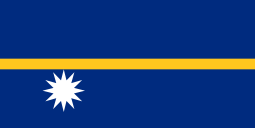Obesity in Nauru

Obesity in Nauru is a major health concern for the nation. In 2007 Forbes.com reported that, according to the World Health Organization's (WHO) latest estimate, Nauru has the highest percentage of overweight inhabitants among all countries. The estimation identified 94.5% of its residents as overweight.[1] The obesity rate is 71.7%,[2] the highest in the world.[3] The definition of "overweight" and "obesity" are based on body mass index (BMI). People with BMI more than or equal to 25 are classified as overweight, and people with BMI more than or equal to 30 are classified as obese.[1]
The average body weight among Nauruans is estimated to be approximately 100 kilograms (220 lb).[2] Nauru has an average BMI between 34 and 35.[4]
Cause of obesity
Before Nauru gained independence in 1968, there was a culture of fishing and gardening. The Nauruan diet then was primarily composed of marine fish, fruits,[2] root vegetables, and coconuts.[3] As per the analysis by Asahi Shimbun correspondent Takaaki Nishiyama, black-and-white-photographs taken during this time depict well-built and fit men and women. But after Nauru gained independence, there was a major economic growth resulting from mining. The profits from the mining activities were distributed among the citizens and Nauru's per capita income became very high. As a consequence, people did not feel the need to work. Over time, the minerals that made the country rich had been mined, causing the nation to sink back into hard economic times. According to a study conducted by the Government of Nauru and the WHO, the import of western food significantly reduced the existing culture of fishing and gardening, and from the 1980s, Nauruans were used to a markedly sedentary lifestyle and an unhealthy diet. This resulted in what the study described as "the worst health conditions in the Pacific region".[2]
Ninety percent of the land area of Nauru is covered with phosphate deposits. A land with phosphate deposits is inarable. This is why Nauru has very little arable land and relies on importing processed food,[3][5] which is high in both sugar and fat,[3] from large Oceanian countries like Australia and New Zealand.[5] Most, if not all, of the diet on Nauru is high fat and high sugar foods, that contain very little nutritional value.
Apart from unhealthy diet, lack of physical exercise, and lack of proper health education, cultural attitude towards obesity has played an important role in the high obesity rate in the country. According to the University of Queensland professor and South Pacific researcher Clive Moore, obesity is seen as a sign of wealth in Nauru.[3]
Consequence
As a consequence of high rate of obesity, Nauru has the highest rate of adult diabetes in the world. The International Diabetes Federation (IDF) identified 31% of Nauruans as diabetic.[5] This rate is as high as 45% among the age group 55-64.[3]
Efforts to curb obesity
Nauruan health authorities have taken steps to curb obesity. People are told to walk around the 3 miles (4.8 km) perimeter of the Nauru International Airport. Exercise sessions and sports are organised routinely.[3]
See also
References
- 1 2 Streib, Lauren (2 August 2007). "World's Fattest Countries". Forbes.com. Retrieved 23 January 2013.
- 1 2 3 4 Nishiyama, Takaaki (27 May 2012). "Nauru: An island plagued by obesity and diabetes". Asahi Shimbun. Retrieved 23 January 2013.
- 1 2 3 4 5 6 7 Marks, Kathy (26 December 2010). "Fat of the land: Nauru tops obesity league". The Independent. Retrieved 23 January 2013.
- ↑ Laurance, Jeremy (4 February 2011). "How tiny Nauru became world's fattest nation". The Independent. Retrieved 23 January 2013.
- 1 2 3 Streib, Lauren (2 August 2007). "Nauru: 94.5 % overweight". Forbes.com. Retrieved 23 January 2013.
